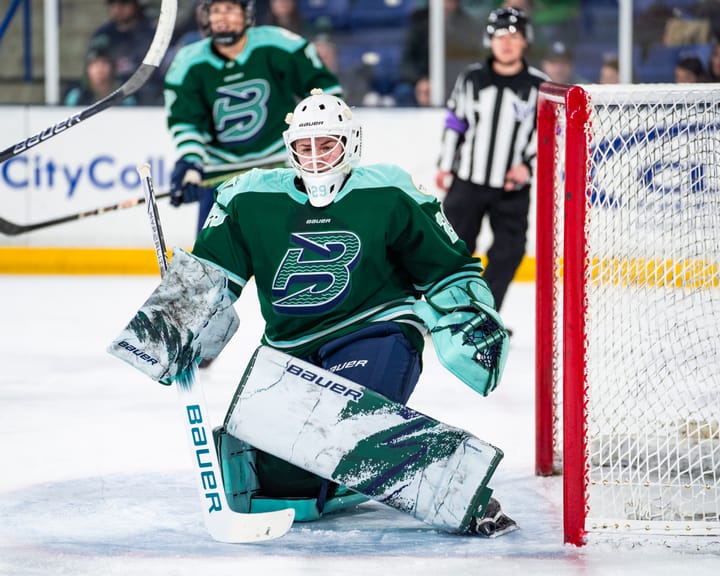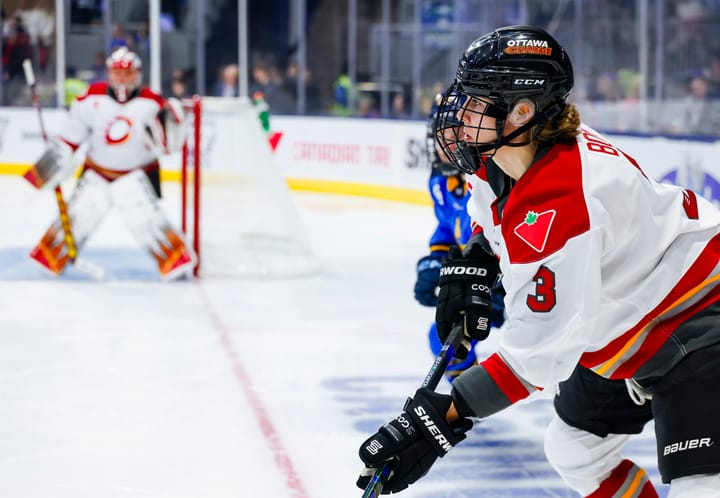NWHL Lake Placid report card: Minnesota Whitecaps
Minnesota showed up for the bubble ready to build on an almost-championship season
All things considered, the Minnesota Whitecaps have to be pleased with how things went on the ice in Lake Placid. They went 3–1–0 in the regular season and bested the Boston Pride by a score of 1–0 in a highly anticipated “rematch” of what would have been the 2020 Isobel Cup Final. That right there was worth the trip to New York.
Thanks to big performances by Amanda Leveille, Nina Rodgers, Audra Richards, and Sydney Baldwin, the Whitecaps were one of the best teams in Lake Placid. They were ready to go as far as Leveille could carry them, which was beginning to look like the 2021 Isobel Cup Final before the NWHL’s “bubble” burst and play was suspended due to an outbreak of COVID-19 and player safety concerns.
Offense: B
The Whitecaps’ offense was outstanding on the power play but underwhelming at even strength. Last season, the top line carried Minnesota’s offense. In Lake Placid, it was Minnesota’s depth forwards who got the job done.
We can’t talk about Minnesota’s offense without talking about Rodgers, who played some of the best hockey of her career in Lake Placid. Rodgers led the team in scoring with six points, which was massive for a team that got just a single goal out of Allie Thunstrom and Jonna Curtis combined. She made big plays in all four games while skating an average of 14:24 TOI/GP. You’d be hard-pressed to think of a player who made a bigger impact with her ice time than Rodgers. She was buzzing around on the opposition’s net all tournament.
Related
Nina Rodgers is seizing the moment in Lake Placid
Minnesota thrived on the advantage, piling up five power-play goals on 19 opportunities — a league-leading 26.3 percent success rate. Rodgers and Meghan Lorence led the team in power-play scoring, with three points each, but the most important player to watch on the advantage was defender Sydney Baldwin. Baldwin picked up two of her three points in Lake Placid on the power play and shined on the top unit in the absence of Amanda Boulier. She thrived in her role as the PP quarterback and didn’t seem to wear down despite all of the ice time she was asked to shoulder.
The Whitecaps’ 2.75 GF/GP was third in Lake Placid behind the Toronto Six and the Boston Pride. However, their –2 even-strength goal differential reveals just how much they depended on the power play to get on the scoreboard. Per InStat, Minnesota was fifth in the league in shot attempts at even strength (37.5) and fifth in shots on goal at evens (22.0). That was surprisingly low for a team that had Minnesota’s scoring depth but, to be fair, we did only see four games of the Whitecaps.
Related
Audra Richards providing strength, skill, and chaos for Whitecaps in Lake Placid
Defense: B
One of the bigger surprises of Lake Placid was how important rookie defender Maddie Rowe was to Minnesota. Rowe averaged 24:37 TOI/GP, second only to Baldwin who more or less skated half of each game with 27:24 TOI/GP. Rowe looked like a reliable stay-at-home defender, as evidenced by her team-leading 19 blocked shots and an average of 14 puck battles in the defensive zone per game. That’s a lot of ice bags.
Baldwin and Rowe also played major roles on Minnesota’s successful penalty kill. The Whitecaps finished Lake Placid with an 85.7% success rate on the kill, second only to the Boston Pride. Obviously, Leveille deserves full marks for her performance in goal on the PK, but credit also belongs to Baldwin, Rowe, Thunstrom, and Curtis, who made up the top unit. Generally speaking, Minnesota’s veteran forwards were great in their own end, and that was most evident on the PK.
Veterans Emma Stauber and Chelsey Brodt-Rosenthal also deserve praise for emerging as a shutdown pair. Stauber averaged 21:50 TOI/GP and Brodt-Rosenthal clocked in at 17:54 but saw more time on the PK than her d-partner. That’s a lot of ice time for a “second” d-pair, especially at even-strength.
So, why are the Whitecaps only getting a “B” here? The short answer is they asked too much of Leveille — to the tune of 39.25 SA/GP — and the coaching staff seemed to have very little faith in the third defensive pair. Sara Bustad finished with an average of 10:51 TOI/GP despite looking strong in her limited use. Rose Alleva saw even less ice time, skating less than four minutes per game. She may have been dealing with an injury, but it was strange to see so little of Bustad, Alleva, and captain Winny Brodt-Brown with such a condensed schedule.
Given the schedule and how much time the Whitecaps spent in their own zone, a more even distribution of ice time might have served Minnesota better. With that said, I’m not a coach and don’t pretend to be one. I just wish we had a better look at Bustad and Alleva in Lake Placid. Bustad, in particular, deserved a bigger role based on what we saw from her in 2019–20 when she played with the Beauts.
Goaltending: A+
Leveille was simply sensational for the Whitecaps. The only goalie who was asked to do more for her team in Lake Placid was Buffalo Beauts’ rookie goaltender Carly Jackson. Really, Lake Placid belonged to the goalies — the average save percentage was .924 (small sample sizes are fun). But Leveille managed to outshine everyone even after allowing five goals in one of her four starts.
Related
Amanda Leveille leading the way for Whitecaps in Lake Placid
Lev faced an average of 38.81 SA60 and posted a .936 Sv% through 242:44 of hockey. She played all but two minutes of the tournament for Minnesota, shut out the Riveters, and held the Boston Pride to a single goal. And while it’s true that she did have some help from her posts, it also looks like at least one of the pucks that beat her didn’t actually go in. We really need goal cams and replay reviews of goals in the NWHL.
A keen-eyed goalie dad just pointed out that Mikyla Grant-Mentis' first goal of the game may not have gone in. Looks like it went crossbar, post, and then out. Wish we had another angle. Tough call for officials to make. https://t.co/jrel6HpWuF
— Mike Murphy (@DigDeepBSB) January 31, 2021
Per InStat, Leveille had an expected goals against (xGA) of 4.2 per game based on her workload and the quality of chances she faced. She posted a 2.47 GAA after four starts. Seriously, think about that for a minute.
MVP: Amanda Leveille
In my opinion, Leveille was the frontrunner for both the Goaltender of the Year and the MVP for her play in Lake Placid. Sure, it was a short tournament and teams didn’t play the same number of games, but we deserve nice things ... and awards are fun. If the league was ready to hand over the Isobel Cup, they should also be ready to hand out individual honors.
The Whitecaps don’t finish with a 3–1–0 record or earn distinction as the second seed for the Isobel Cup Semifinals without Leveille. They also don’t beat the Pride or Riveters in epic goalie duels against Lovisa Selander and Sonjia Shelly without her, or come back from a 5–1 deficit to defeat the Toronto Six on Jan. 24. She kept the Whitecaps afloat. She made more breakaway saves and saves on rushes than I care to count — but I assure you, there were a bunch.
Honestly, what more can we say or write about Lev that we haven’t said or written already? She’s consistent, she’s tough as nails, she’s humble, and she's absolutely clutch. Amanda Leveille is a superstar. And she played like one in Lake Placid.
Data courtesy of NWHL.zone, InStat, and HerHockeyCounts.com.





Comments ()